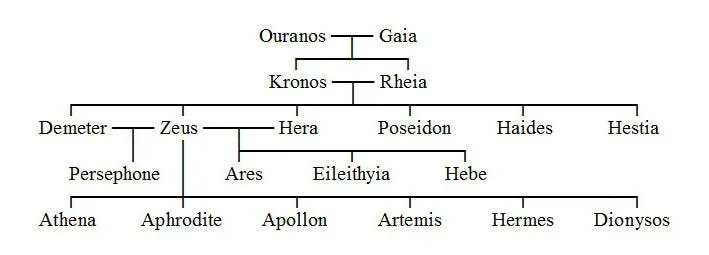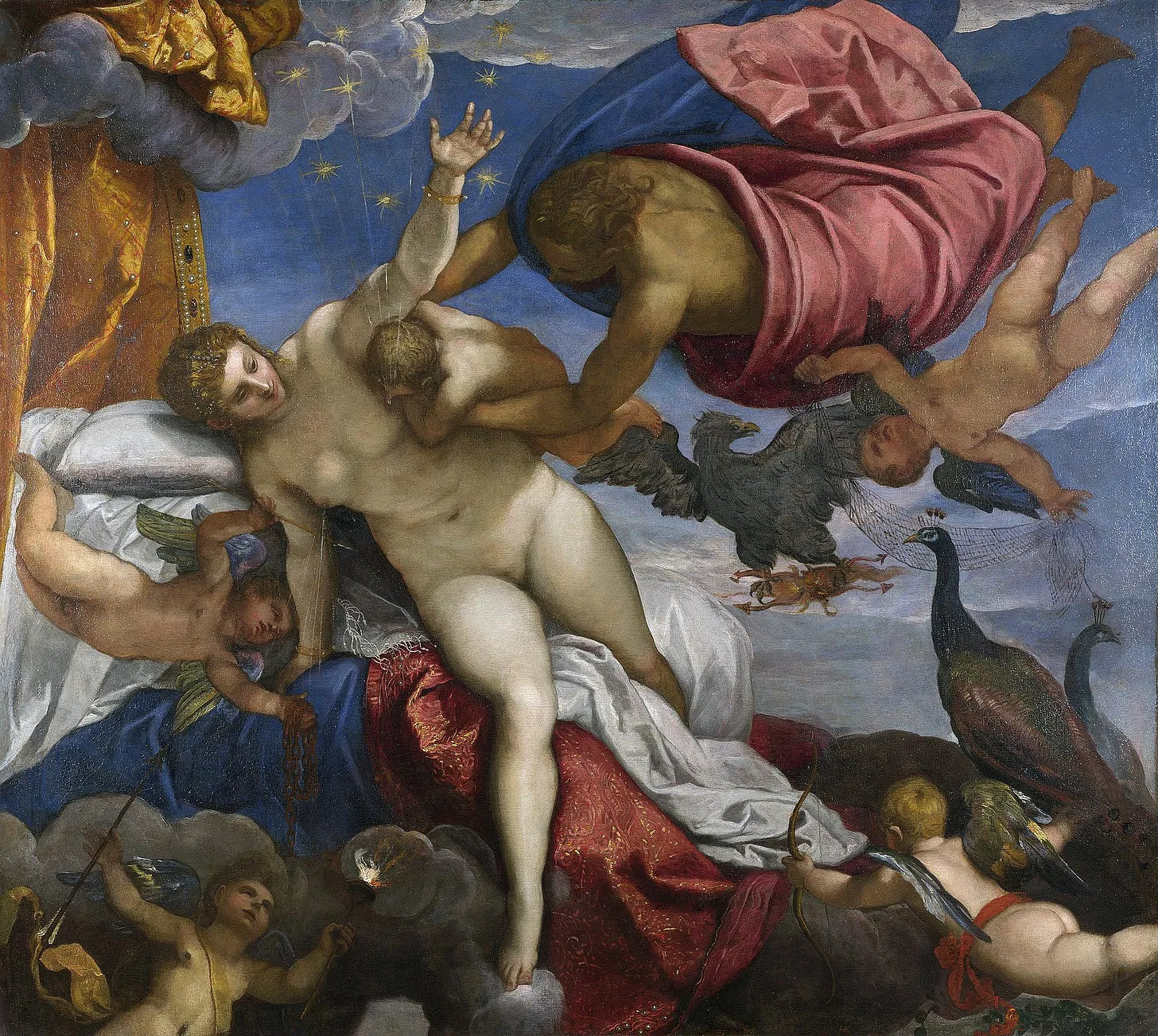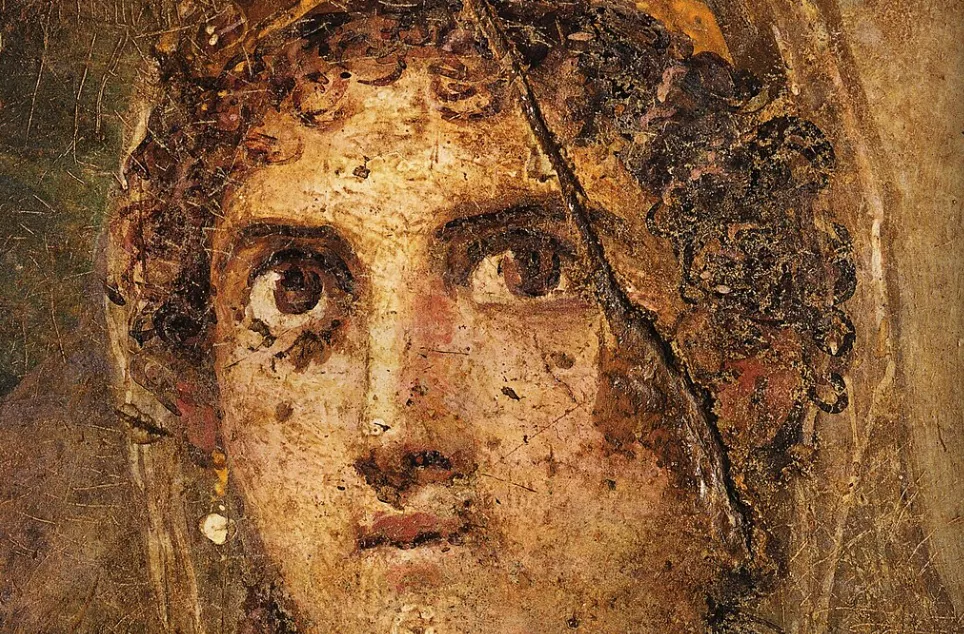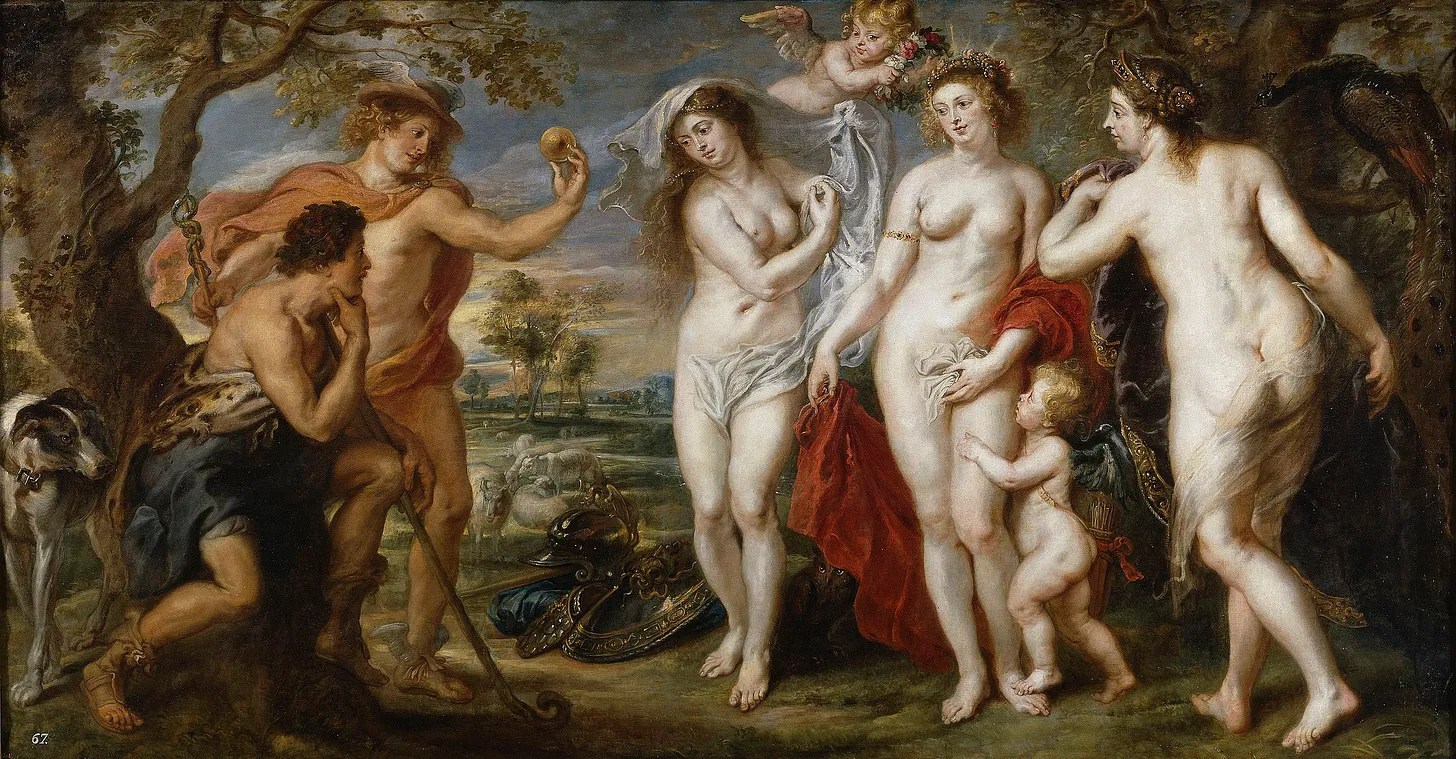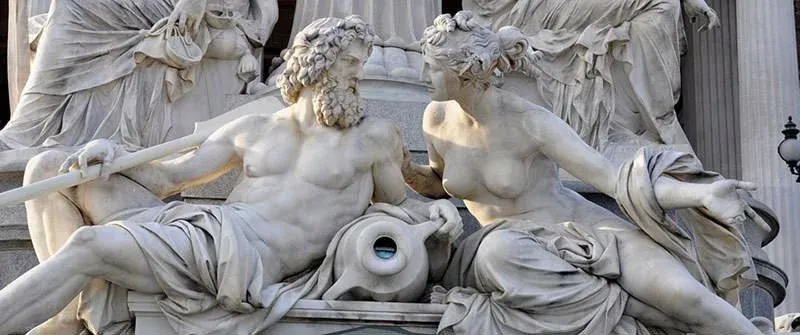Of all the unhappy couples in Greek literature perhaps the unhappiest is that of the Olympian first couple themselves. As the goddess of marriage, a neglected Hera plays the quintessential role of the jealous wife for the ever-unfaithful Zeus—the lord of the gods at Mount Olympus. Often working on the sidelines against her husband’s interests, Hera displays a proclivity for instigating strife and mayhem—- particularly against Zeus’s vast collection of paramours and their offspring. Never mind that his paramours more closely resemble victims than lovers—-by no means does she let this stand in the way of divine retribution.
Hera’s facetious depiction in Greek literature as a jealous and vengeful wife is in marked contrast to the piety that her cult engendered. Throughout the Greek world, Hera was bestowed the greatest accolades of all the goddesses in the Greek pantheon; she is regarded as the patron goddess of marriage and the goddess of women and childbirth too. As the only wedded of the original Olympian goddesses, her presence loomed large at weddings where she presided over lawful unions and helped protect women from harm during childbirth. Moreover, Hera holds an exalted place in the Olympian pantheon; not only is she the wife of Zeus but she is also his sister. In Hesiodic genealogy, Hera was the eldest daughter of the king and queen of the Titans: Kronos and Rhea.
In consideration of the multiple honors bestowed on her—-oftentimes to the exclusion of more benevolent deities—- it is difficult to reconcile the vicious Hera as she is portrayed in Greek literature to the benevolent Hera who is worthy of celebration. So why was Greek literature unkind to Hera? Could the stormy relationship between Zeus and Hera be reflective of a culture clash? What can we learn from her earliest temples and how can we ascertain the historical origins — the pre-Greek roots— of Hera and her cult?
Greek Literature’s Depiction of Hera
Though the stories of Hera’s savageness are too numerous to mention in the confines of this article, the following is a sampling of some of her more notorious. First there is the woeful tale of Io, Hera’s first priestess. Although Io spurns Zeus’s unwelcome advances, ultimately she is powerless to resist the will of this mightiest of all gods. In competing narratives, either Zeus transforms Io into a heifer—ostensibly to hide her from the wrath of Hera—-or Hera does the deed herself. Yet Hera goes one step further by fastening Io to an olive tree and employing the hundred-eyed Argus to keep his various eyes on Io to make sure that she has no further assignations with Zeus. Hera’s malevolent nature still not quelled, she then sets a gadfly to pester and mercilessly pursue the unfortunate Io to the ends of the earth.
Another of her targets is Sermele, mother of Dionysis by Zeus. In Hera’s disguise as a nurse, she encourages Semele to ask Zeus to reveal himself in all his divine grandeur knowing full well that the sight of his unshielded divinity would instantly destroy her —-which it does. Zeus does manage to save the baby Dionysis by sewing him into his leg. The next to fall prey to Zeus’s unbounded desire—-and Hera’s endless wrath—-is the lovely nymph Callisto. Once Hera discovers that Callisto is pregnant with Zeus’s child, she transforms her into a bear. Finally, there is the tale of princess Alcmene, described as the tallest and the most beautiful of mortal women. Once pregnant with Zeus’s child, Hera tries to prevent the birth by tying Alcmene’s legs in knots. Her efforts, however, are thwarted and her arch-nemesis, the Greek hero Heracles, is born.
As if that were not enough to rankle Hera, in one tradition Zeus tricks her into nursing the half mortal/half divine creature. Because he was being suckled by a goddess, the infant would grow strong and fierce. After Hera discovers the infant’s identity she throws the baby off her breast and her breast milk splatters across the sky forming the Milky Way galaxy. But the fall was not enough to foil the infant hero, so Hera sent two snakes to strangle him while he lay sleeping in his cot. The snakes would lose the contest when baby Heracles strangles them instead using their dead carcasses as toys. The enmity between Hera and Heracles is legendary and continues into his adulthood when she finally drives him into madness causing him to kill his wife and children.
The Pre-Greek History
Before delving into why Greek literature treated Hera poorly, it is important to have an understanding of pre-Greek (or pre-Hellenic[1]) history. In the 18th century BCE, the Mycenaeans invaded the Aegean region[2] conquering the indigenous pre-Hellenic mainland. Representing the first characteristically Greek civilization, Mycenaean Greece dominated the last phase of the Bronze Age from approximately 18th to 11th century BCE. They are called the “first Greeks” because they were the first to use the Indo-European Greek language. To be sure, subsequent DNA testing has revealed a common genetic heritage between today’s Greeks and their Mycenaean ancestors. As an advanced warrior society, the Mycenaeans were renowned for their palatial states, urban centers, and seafaring skills. For a time they were under Minoan political hegemony but by 1400 BCE they added the legendary Minoan island of Crete and nearby islands to their long list of conquests, thus becoming the dominant power in the entire region.
While their building achievements are unmistakable, when it comes to extolling their other triumphs, the Mycenaeans are silent. In their heavily bureaucratic society, their writing system—syllabic Linear B—- was used chiefly for record keeping and inventories. Though they were without writing, they were not without stories. The oldest legends of humankind were hymns or songs that preceded the written word by hundreds, if not thousands, of years. Narrative writing in the Greek world does not come into being until the eighth century BCE—relatively late in the hourglass of the ages.[3] The poet (or poets) known as Homer was the beneficiary of a rich tradition of mythological and historical stories—an intermelding of traditions by both the conquerors and the conquered—that had been passed down from countless generations of oral poets who had preceded him.[4]
When the Mycenaeans subsumed the pre-Greeks, they recast the indigenous myths and adopted some elements of the local culture as their own. Thus the pre-Hellenic myths of the vanquished people became appropriated by the conquerors; the invader sky gods married or raped the indigenous earth goddesses and replaced matricentric elements with patriarchal ones. Deeply buried beneath the greater Olympian pantheon, lay an underpinning of the old great goddess religions. By reframing the mythology, the great goddesses were absorbed into the reformulated myths and recast as wives, sisters, or daughters; Hera, Demeter, Athena, Aphrodite, and Artemis were all great mother goddesses in the pre-Greek world.
Hera Before Zeus
Based on archeological evidence, such as artifacts and temples (which will be discussed later), it is evident that Hera originated in the pre-Greek Aegean. Thus the mythological marriage of Hera and Zeus symbolized the union of the pre-Hellenic Hera with the Olympian pantheon. In part, derived from iconography, legends, and the numerous plants and animals with which she was associated, Hera was once an earth mother goddess, mistress of animals, the queen of heaven, and the female origin of all things[5] who ruled over the earth and sky—- notably without a male consort. She was the goddess of women, fecundity, and connected to the three stages in a woman’s life. Her dominion also included vegetation and had underworld or chthonic associations. Indicative of her great goddess status was her link to parthenogenesis or virgin birth. Her parthenogenetic ability is referred to several times in Homer; she gave birth to both Hephaestus and Hebe in this fashion. The prehistoric notion that women could bear children without the help of males is emblematic of an archaic matrifocal era—before the Mycenaean invasions.
Herodotus reports that Hera was an indigenous deity associated with agriculture. Often referred to as “cow-eyed” in the Iliad, Hera is associated with cows who symbolized motherhood, abundance, and fertility in general. Because the pre-Greeks far surpassed the Mycenaeans in farming, the Mycenaeans quickly adopted Hera from the Pelasgians[6]—the name used by the ancient Greeks for the indigenous pre-Greeks.
Not just a foil…
Over the course of several hundred years Hera’s status was brought down; this greatest of goddesses from the pre-Greek world was disempowered and ultimately transformed into a quarrelsome wife— used as a foil for the all-mighty sky god, Zeus.[7]
The quarrelsomeness that Hera generates is indicative of the clash or the forced merging of the indigenous and invading cultures. Noted Hellenic scholar Carl Kerenyi argues: “the tension between Zeus and Hera….. is not merely a poetic fiction.”[8] Time and again, Hera, the formidable native queen, refuses to subordinate herself to the invading sky god. While other gods are deferential to Zeus, Hera gives Zeus as good as she gets. Unafraid of his wrath, she steadfastly asserts herself. Even though she is married to the mightiest of gods, who threatens her beyond measure, Hera perseveres as an independent agent.
In Homer’s the Iliad—-one of the oldest extant written stories of humankind—- Hera’s strength and sovereignty are demonstrated by her continual clashes with Zeus when she tries to thwart his attempts to favor the Trojan army. The antecedent action leading up to the events in the Iliad helps explain her animosity toward the citadel of Troy. In a narrative referred to as the “Judgment of Paris,” Paris—prince of Troy—- selects Aphrodite (goddess of love) as the most beautiful of the three Olympian goddesses, which also include Athena and Hera. It is Paris’s insult which fuels her intense hatred of the Trojans. Hera defies Zeus’s orders and collaborates with Athena to provide the Greeks with every advantage.
In Chapter One the clash between Zeus and Hera is laid out. On account of a slight to her son Achilles, the sea-nymph Thetis, beseeches Zeus to grant the Trojans “victory after victory til the Achaean (Greek) armies pay my dear son back.” In this scene, the almighty Zeus is fearful of a clash with Hera. First he replies: “Disaster. You will drive me to war with Hera.” Then a panicked Zeus asserts: “Away with you now, Hera might catch us here.” Nevertheless, he agrees to Thetis’ request. Afterward, in the hall of the gods, while the other gods obsequiously genuflect to the authority of Zeus, Hera confronts him as an equal and instead berates him: “So, who of the gods this time, my treacherous one, was hatching plans with you? ….Dread majesty, son of Cronus…..I suspect you bowed your head in assent to her (Thetis)…” In reply Zeus becomes angry and threatens to harm Hera if she disobeys him. “Maddening one …be quiet now. Obey my orders, for fear the gods are powerless to protect you when I come to throttle you with my irresistible hands.” His threats to harm Hera are continual throughout the epic, but although Hera knows his punishments only too well, she never acquiesces. No other god had the courage to give the lord of gods his due.
Hera is both covertly and overtly defiant of her husband’s interests in Chapter Fourteen titled “Hera Outflanks Zeus.” “What could she do? Queen Hera wondered, her eyes glowing wide….how could she outmaneuver Zeus, the mastermind, this Zeus with his battle-shield of storm and thunder?” She decides that her best strategy is to seduce him then lull him to sleep with the help of the goddess Sleep. Her plan works and she helps the Greeks gain the upper hand. When Zeus discovers her perfidy, he screams “Uncontrollable Hera—you and your treachery…I’ll whip you stroke on stroke. Don’t you recall the time I strung you in mid-air and slung those two massive anvils down from your feet and lashed both hands with a golden chain you could not break?” Zeus is referring to the punishment he thrust upon Hera after discovering one of her attempts to sabotage his beloved son, Heracles.
Despite Hera’s immortality she is capable of being destroyed or severely injured by the mightiest of gods. Consider the sad fate of the Titan god, Prometheus, who had the temerity to go against the will of Zeus by giving humans fire—hence progress. As a result of his transgressions, his liver is devoured each day by an eagle—one of Zeus’s sacred animals —-and regenerates itself each night to be devoured the following day in a never ending cycle. Yet for all Zeus’s threats, Hera never backs down. Many scholars contend that her overt willfulness against Zeus is an expression of how powerful a deity Hera was in the pre-Hellenic world.
Cultural Integration: The Union
While Hera was the supreme pre-Hellenic goddess of the Aegean, Zeus held the position of supreme deity among the Mycenaeans. Based on archaeological evidence, there is a clear difference in origins between Zeus and Hera. Acclaimed German scholar of archaeology, Erika Simon posits: “Zeus was brought along into the Aegean by Greek tribes migrating from the north. Originally, he was worshiped in the open sky…it is no accident that his wife there (in Dodona —northwestern Greece) was not Hera but Dione, who like him, was worshiped under the oak trees.”[9] As two supreme deities who each ruled autonomously, Hera and Zeus were imperfectly matched as husband and wife. If their tumultuous relationship indicates a clash between the two disparate cultures, could their courtship give us a glimpse into how the two cultures began to integrate?
In yet another seduction scenario, after attempting unsuccessfully to court a reluctant Hera, Zeus resorts to trickery to win her affections. The traveler and geographer Pausanias reports that after becoming separated from other gods and goddesses, Hera gets caught in a thunderstorm—put in action by the thunder god Zeus himself. During the storm, one of her sacred animals, the cuckoo, lands on her lap half frozen and shivering. After covering the creature with her robe, she cradles the cuckoo against her breast whereupon the bird transforms himself into Zeus— her steadfast suitor—and proceeds to rape her. In true patriarchal fashion, she was shamed by the rape he committed so she agrees to marry him. In another version of the myth, due to the prohibition of brother and sister unions, she appeals to her mother for permission to marry Zeus.
Hungarian scholar in classical philology, Carl Kerenyi, tells how the tale demonstrates Zeus as an intruder to the matriarchal domain in which Hera was enthroned as ruler. The union of siblings, however, was allowed only for the gods, thus Hera could become Zeus’s wife.[10] The sacred marriage between Hera and Zeus is termed hieros gamos and is used as the prototype for human wedlock in order to ensure abundance, prosperity, and fertility. In the Greek world, all lawful marriages were sacred to Hera and Zeus and the union of the first Olympian couple—-symbolized by the lunar cow with the solar bull —-was celebrated amid much fanfare each year.
According to the ancient Greek poet, Callimachus (305 BCE-240 BCE), Hera and Zeus’ wedding feast— or in some translations “their desire” —-lasted for three hundred years. Some believe that three hundred years may indicate a period of theological flux when Hera’s place in the Olympian pantheon was not yet fixed.[11] In fact, the Olympian pantheon as we know it today was not determined until the sixth century BCE when in 522 the Athenian tyrant, Pisistratus established the Altar of the Twelve Gods.[12]
Hera’s House: Ancient Temples
In an example of mythology mirroring history, three hundred years comes up again. Evidence was unearthed of Hera worship in the form of a prehistoric wooden structure dating back to the ninth century BCE[13]—fully three hundred years before the Olympian pantheon was etched in stone. Greek temples, renowned for their massive stone columns, were originally wooden structures; oval prehistoric-style dwellings resembling wooden houses. Though some scholars believe that Hera may have been worshiped in such dwellings long before the first millennium BCE, Hera’s cult—more than any other—greatly influenced the development of Greek temple architecture.[14] Famed Hellenic scholar, Walter Burkert contends: “Hera has a unique connection with the temple: the earliest and most important temples are dedicated to her.”[15]
The following are some noteworthy examples of her earliest temples. The Heraion of Samos is Hera’s birthplace on the island of Samos and her temple at Perachora near Corinth both date to the ninth century BCE; other than the Temple of Apollo in Thermon, no other temple has been unearthed in post-Mycenaean Greece earlier than this. Dedicated exclusively to Hera, they predated the Greek Doric order of architecture—the oldest of the three orders—- by nearly three hundred years.
The Heraion of Samos was considered the greatest engineering feat of its day superseding all other sanctuaries.[16] It was also the first roofed temple sanctuary. In fact, the first indications of Hera worship in the area date back to the latter half of the second millennium, illustrating that the Hera cult was already active when the Mycenaeans invaded.
Called “Argive Hera” in the Iliad, Argos was another of her major cult centers with an extensive sanctuary—which served several communities —-reaching back into the eighth century BCE. A pre-Hellenic aniconic depiction of Hera in a pillar (no longer extant) suggests that she may have been worshiped there long before this time.
The Temple of Hera at Olympia, also called the Heraion of Olympia, is a site where evidence of cult activity reaches back to the tenth century BCE. Originally built from wood in the seventh century BCE then replaced with stone, the temple was still extant when Pausanias in the second century CE commented that Hera was seated on a throne, while as an afterthought a bearded and helmeted Zeus stands by her side.[17] Simon notes that Hera’s temple was in existence a century and a half before the Temple of Zeus at Olympia was built and goes on to say that wherever temples to both Hera and Zeus exist, excavation has revealed that Hera’s temple is always the oldest.[18]
The ninth and eighth centuries BCE saw the construction of two temples dedicated to Hera in Perachora. In a testament to how aligned her cult was to temple architecture, clay or limestone houses are among the votive offerings for Hera in Perachora, Argos, and Samos. According to Simon, the votive homes from Perachora depict the structure in a transitional phase between prehistoric and Doric building styles.[19]
An article about Hera’s association with temples would be remiss without mentioning her ruins at Paestum. Located south of Naples on the coast of the Tyrrhenian Sea, posterity owes a debt of gratitude to its swampy marshlands for helping preserve some of the earliest examples of Doric architecture in the Greek world. From the fall of the ancient world in the fourth century CE through the Middle Ages, malaria would emerge, making Paestum uninhabitable. During a time when Greek temples were systematically dismantled and quarried for their stone, the Doric temples of Paestum were largely forgotten and left alone. Two of the three Doric order (sixth and fifth century BCE) temples were dedicated to Hera.
More than any other Greek deity, Hera served as the inspiration for the creation of the Greek temple—an iconic symbol that for many has come to characterize ancient Greece itself. Though we may never know how Hera was worshiped by the pre-Greeks, in the early Greek world, the development of temple architecture on her behalf is witness to the reverence the population must have had for her. It is ironic that evidence of her early worship is permanently fixed in a time period as overlooked and undervalued as she is. The Greek Dark Age—-or more appropriately termed the Sub-Mycenaean age (ca 1100 BCE-800 BCE) —-is an era distinguished by a decline in wealth and advancement when, ostensibly, no discernible progress was made. Perhaps it is a testament to Hera’s greatness that in an era characterized by poverty and an overall lack of engineering, the early Greeks found the resources to build colossal monuments in her honor, some still standing to this day.
Crumbling Status: Hera’s fall from Grace
While the passage of time may have been kind to her temples, Hera has not always fared as well. In the beginning, she reigned supreme as the great mother goddess in a religion of the soil that honored nature and celebrated women’s extraordinary reproductive powers. After the Mycenaeans invaded her sovereignty was suppressed and she had to share the spotlight with an oftentimes cruel and warlike male who would eventually take center stage. With the advent of writing, she was further reduced to a woman whose only identity is through her husband and degraded to the pettiest of characters; a caricature of unlikeability. In a nod to the power of cultural memory, despite her many diminutions, Hera remained the paragon of goddesses that the population, particularly its women, continued to celebrate in artwork, shrines, temples and annual festivals, from the dawn of the Archaic Age to the twilight of the Hellenistic Era.
—
About the Author: Long fascinated with the ancient world, Mary Naples earned an MA in Humanities with an emphasis in Women’s Studies from Dominican University of California. While at Dominican, she discovered a deep enthusiasm for unearthing stories about ancient women that have long been buried.
Since graduating in 2013, she has been a contributing writer for Classical Wisdom Weekly. Her book, Cult of the Captured Bride: How Ancient Women Took Power —published in April of 2023 —-is about a feminine fertility festival which enfranchised its female participants. Her newest book, “Unsung Heroes” delves into the seldom seen and rarely heard women in the hyper-patriarchal ancient world, set to come out in June 2024.
Footnotes:
[1] The Greeks referred to themselves as Hellenes and the ancient Greek world was termed Hellas. The word “Greek” comes from the Latin “Graeci.”
[2] Likely the Mycenaeans invaded from the north though there is not full consensus on this within the academic community,
[3] Between the Mycenaean era and the Archaic age of ancient Greece lies a four-hundred year period known as the Greek Dark Age or the sub-Mycenaean period characterized by the absence of writing and most forms of culture and the destruction and or abandonment of the great Mycenaean cities and palaces.
[4] “For literature Homer is the beginning, though every scholar is aware that he is nowise primitive…..Homer presents, not a starting point, but a culmination…beneath this splendid surface lies a stratum…at once more primitive and more permanent.” Jane Ellen Harrison, Prolegomena to the Study of the Greek Religion.
[5] One of her many titles in the pre-Greek world. Rigoglioso, Virgin Mother Goddesses of Antiquity, 65.
[6] Herodotus. Histories, 2.50
[7] “Compulsory marriage of Hera and Zeus reflected the subjugation of a ‘primitive race’ to Achaean (Greek) invaders.” H. D Muller, footnoted in Prolegomena to the Study of Greek Religion, Harrison, 316.
[8] Zeus and Hera: Archetypal Image of Father, Husband, and Wife, (Princeton: Princeton University Press, 1975, 57.
[9] Simon, Erika. The Gods and Goddesses of Ancient Greece. Madison: University of Wisconsin Press, 39.
[10] In matriarchal traditions incest between brother and sister was forbidden. C. Kerenyi. Zeus and Hera, 123. Although not in the Greek world, sibling marriage (between royals) was sanctified in many ancient cultures most notably, Egypt.
[11] M. Rigoglioso. Virgin Mother Goddesses of Antiquity, 67.
[12] Thucydides. History of the Peloponnesian War.
[13] Simon, 40.
[14] Simon, 39. Burkert, 131.
[15] Burkert, Greek Religion, 131.
[16] The Heraion was rebuilt in the sixth century BCE over its Mycenaean foundation four times larger than the majestic Parthenon in Athens. Hera became visible as Zeus’s wife in the Samian cult as late as the seventh century BCE but even then evidence indicates that Zeus’s influence on her cult was minimal. Rigoglioso. Virgin Mother Goddesses of Antiquity, 69.
[17] Pausanias. Description of Greece, 5.17.1
[18] Simon, 39.
[19] Ibid, 40.

